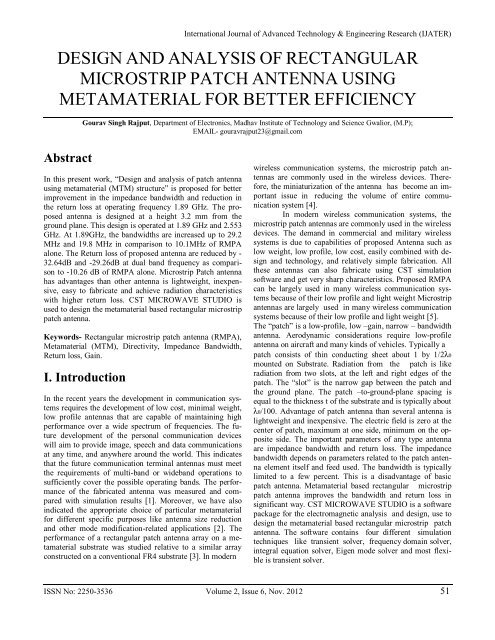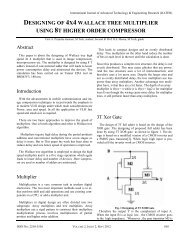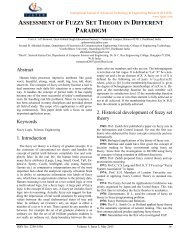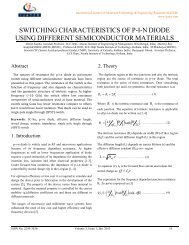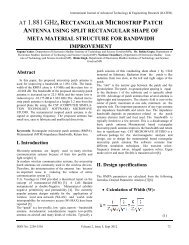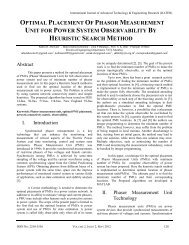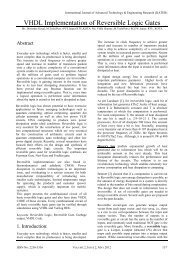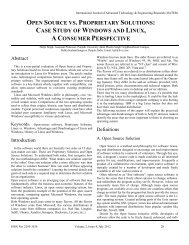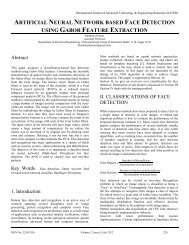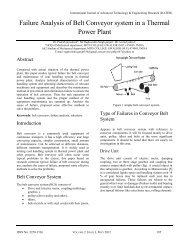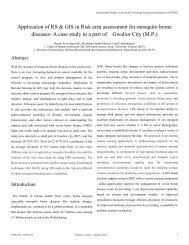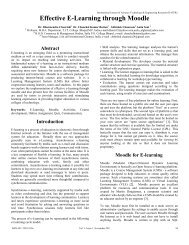design and analysis of rectangular microstrip patch antenna ... - ijater
design and analysis of rectangular microstrip patch antenna ... - ijater
design and analysis of rectangular microstrip patch antenna ... - ijater
You also want an ePaper? Increase the reach of your titles
YUMPU automatically turns print PDFs into web optimized ePapers that Google loves.
International Journal <strong>of</strong> Advanced Technology & Engineering Research (IJATER)<br />
DESIGN AND ANALYSIS OF RECTANGULAR<br />
MICROSTRIP PATCH ANTENNA USING<br />
METAMATERIAL FOR BETTER EFFICIENCY<br />
Gourav Singh Rajput, Department <strong>of</strong> Electronics, Madhav Institute <strong>of</strong> Technology <strong>and</strong> Science Gwalior, (M.P);<br />
EMAIL- gouravrajput23@gmail.com<br />
Abstract<br />
In this present work, “Design <strong>and</strong> <strong>analysis</strong> <strong>of</strong> <strong>patch</strong> <strong>antenna</strong><br />
using metamaterial (MTM) structure” is proposed for better<br />
improvement in the impedance b<strong>and</strong>width <strong>and</strong> reduction in<br />
the return loss at operating frequency 1.89 GHz. The proposed<br />
<strong>antenna</strong> is <strong>design</strong>ed at a height 3.2 mm from the<br />
ground plane. This <strong>design</strong> is operated at 1.89 GHz <strong>and</strong> 2.553<br />
GHz. At 1.89GHz, the b<strong>and</strong>widths are increased up to 29.2<br />
MHz <strong>and</strong> 19.8 MHz in comparison to 10.1MHz <strong>of</strong> RMPA<br />
alone. The Return loss <strong>of</strong> proposed <strong>antenna</strong> are reduced by -<br />
32.64dB <strong>and</strong> -29.26dB at dual b<strong>and</strong> frequency as comparison<br />
to -10.26 dB <strong>of</strong> RMPA alone. Microstrip Patch <strong>antenna</strong><br />
has advantages than other <strong>antenna</strong> is lightweight, inexpensive,<br />
easy to fabricate <strong>and</strong> achieve radiation characteristics<br />
with higher return loss. CST MICROWAVE STUDIO is<br />
used to <strong>design</strong> the metamaterial based <strong>rectangular</strong> <strong>microstrip</strong><br />
<strong>patch</strong> <strong>antenna</strong>.<br />
Keywords- Rectangular <strong>microstrip</strong> <strong>patch</strong> <strong>antenna</strong> (RMPA),<br />
Metamaterial (MTM), Directivity, Impedance B<strong>and</strong>width,<br />
Return loss, Gain.<br />
I. Introduction<br />
In the recent years the development in communication systems<br />
requires the development <strong>of</strong> low cost, minimal weight,<br />
low pr<strong>of</strong>ile <strong>antenna</strong>s that are capable <strong>of</strong> maintaining high<br />
performance over a wide spectrum <strong>of</strong> frequencies. The future<br />
development <strong>of</strong> the personal communication devices<br />
will aim to provide image, speech <strong>and</strong> data communications<br />
at any time, <strong>and</strong> anywhere around the world. This indicates<br />
that the future communication terminal <strong>antenna</strong>s must meet<br />
the requirements <strong>of</strong> multi-b<strong>and</strong> or wideb<strong>and</strong> operations to<br />
sufficiently cover the possible operating b<strong>and</strong>s. The performance<br />
<strong>of</strong> the fabricated <strong>antenna</strong> was measured <strong>and</strong> compared<br />
with simulation results [1]. Moreover, we have also<br />
indicated the appropriate choice <strong>of</strong> particular metamaterial<br />
for different specific purposes like <strong>antenna</strong> size reduction<br />
<strong>and</strong> other mode modification-related applications [2]. The<br />
performance <strong>of</strong> a <strong>rectangular</strong> <strong>patch</strong> <strong>antenna</strong> array on a metamaterial<br />
substrate was studied relative to a similar array<br />
constructed on a conventional FR4 substrate [3]. In modern<br />
wireless communication systems, the <strong>microstrip</strong> <strong>patch</strong> <strong>antenna</strong>s<br />
are commonly used in the wireless devices. Therefore,<br />
the miniaturization <strong>of</strong> the <strong>antenna</strong> has become an important<br />
issue in reducing the volume <strong>of</strong> entire communication<br />
system [4].<br />
In modern wireless communication systems, the<br />
<strong>microstrip</strong> <strong>patch</strong> <strong>antenna</strong>s are commonly used in the wireless<br />
devices. The dem<strong>and</strong> in commercial <strong>and</strong> military wireless<br />
systems is due to capabilities <strong>of</strong> proposed Antenna such as<br />
low weight, low pr<strong>of</strong>ile, low cost, easily combined with <strong>design</strong><br />
<strong>and</strong> technology, <strong>and</strong> relatively simple fabrication. All<br />
these <strong>antenna</strong>s can also fabricate using CST simulation<br />
s<strong>of</strong>tware <strong>and</strong> get very sharp characteristics. Proposed RMPA<br />
can be largely used in many wireless communication systems<br />
because <strong>of</strong> their low pr<strong>of</strong>ile <strong>and</strong> light weight Microstrip<br />
<strong>antenna</strong>s are largely used in many wireless communication<br />
systems because <strong>of</strong> their low pr<strong>of</strong>ile <strong>and</strong> light weight [5].<br />
The “<strong>patch</strong>” is a low-pr<strong>of</strong>ile, low –gain, narrow – b<strong>and</strong>width<br />
<strong>antenna</strong>. Aerodynamic considerations require low-pr<strong>of</strong>ile<br />
<strong>antenna</strong> on aircraft <strong>and</strong> many kinds <strong>of</strong> vehicles. Typically a<br />
<strong>patch</strong> consists <strong>of</strong> thin conducting sheet about 1 by 1/2λ0<br />
mounted on Substrate. Radiation from the <strong>patch</strong> is like<br />
radiation from two slots, at the left <strong>and</strong> right edges <strong>of</strong> the<br />
<strong>patch</strong>. The “slot” is the narrow gap between the <strong>patch</strong> <strong>and</strong><br />
the ground plane. The <strong>patch</strong> –to-ground-plane spacing is<br />
equal to the thickness t <strong>of</strong> the substrate <strong>and</strong> is typically about<br />
λ0/100. Advantage <strong>of</strong> <strong>patch</strong> <strong>antenna</strong> than several <strong>antenna</strong> is<br />
lightweight <strong>and</strong> inexpensive. The electric field is zero at the<br />
center <strong>of</strong> <strong>patch</strong>, maximum at one side, minimum on the opposite<br />
side. The important parameters <strong>of</strong> any type <strong>antenna</strong><br />
are impedance b<strong>and</strong>width <strong>and</strong> return loss. The impedance<br />
b<strong>and</strong>width depends on parameters related to the <strong>patch</strong> <strong>antenna</strong><br />
element itself <strong>and</strong> feed used. The b<strong>and</strong>width is typically<br />
limited to a few percent. This is a disadvantage <strong>of</strong> basic<br />
<strong>patch</strong> <strong>antenna</strong>. Metamaterial based <strong>rectangular</strong> <strong>microstrip</strong><br />
<strong>patch</strong> <strong>antenna</strong> improves the b<strong>and</strong>width <strong>and</strong> return loss in<br />
significant way. CST MICROWAVE STUDIO is a s<strong>of</strong>tware<br />
package for the electromagnetic <strong>analysis</strong> <strong>and</strong> <strong>design</strong>, use to<br />
<strong>design</strong> the metamaterial based <strong>rectangular</strong> <strong>microstrip</strong> <strong>patch</strong><br />
<strong>antenna</strong>. The s<strong>of</strong>tware contains four different simulation<br />
techniques like transient solver, frequency domain solver,<br />
integral equation solver, Eigen mode solver <strong>and</strong> most flexible<br />
is transient solver.<br />
ISSN No: 2250-3536 Volume 2, Issue 6, Nov. 2012 51
International Journal <strong>of</strong> Advanced Technology & Engineering Research (IJATER)<br />
V.G. Veselago in 1968 provided a theoretical report on the<br />
concept <strong>of</strong> metamaterial (MTM) [6]. A Left- H<strong>and</strong>ed metamaterial<br />
or double-Negative Metamaterial exhibits negative<br />
permittivity <strong>and</strong> permeability [7]. The currently popular<br />
<strong>antenna</strong> <strong>design</strong>s suitable for the applications <strong>of</strong> wireless<br />
local area network (WLAN) <strong>and</strong> world- wide interoperability<br />
for microwave access (Wi-MAX) have been reported<br />
[8].<br />
II. Design specifications<br />
The RMPA parameters are calculated from the following<br />
formulas. Desired Parametric Analysis [9],[10].<br />
Calculation <strong>of</strong> Width (W):<br />
Where<br />
C = free space velocity <strong>of</strong> light,<br />
Ɛr =Dielectric constant <strong>of</strong> substrate<br />
The effective dielectric constant <strong>of</strong> the<br />
<strong>rectangular</strong> <strong>microstrip</strong> <strong>patch</strong> <strong>antenna</strong>:<br />
(1)<br />
III. Analysis <strong>of</strong> Patch Antenna<br />
<strong>and</strong> Metamaterial Structure with<br />
Simulated Results<br />
The Rectangular Microstrip Patch Antenna is <strong>design</strong>ed on<br />
FR-4 (Lossy) substrate at 50Ω matching impedance, dielectric<br />
constant εr = 4.3 <strong>and</strong> height from the ground plane<br />
d=1.6mm.The parameter <strong>of</strong> <strong>rectangular</strong> <strong>microstrip</strong> <strong>patch</strong><br />
<strong>antenna</strong> are L= 35.8462 mm, W= 46.0721 mm, Cut<br />
Width= 5mm, Cut Depth= 10mm, length <strong>of</strong> transmission<br />
line feed= 35.58mm, with width <strong>of</strong> the feed= 3mm shown<br />
in figure1.<br />
The simple RMPA is inspired by metamaterial structure at<br />
1.89 GHz.<br />
Table1. Rectangular Microstrip Patch Antenna Specifications<br />
Parameters Dimension Unit<br />
Dielectric constant<br />
4.3 -<br />
Loss tangent .02 -<br />
(tan )<br />
Thickness (h) 1.6 Mm<br />
Operating 1.89 <strong>and</strong> 2.553 GHz<br />
frequency<br />
Length L 35.85 Mm<br />
Width W 46.07 Mm<br />
Cut width 5 Mm<br />
Cut depth 10 Mm<br />
Path length 35.57 Mm<br />
Actual length <strong>of</strong> the <strong>patch</strong> (L):<br />
(2)<br />
Calculation <strong>of</strong> length extension:<br />
(3)<br />
Figure1. Rectangular <strong>microstrip</strong> <strong>patch</strong> <strong>antenna</strong> at 1.89 GHz.<br />
(4)<br />
CST-s<strong>of</strong>tware is used to <strong>design</strong> the Rectangular <strong>microstrip</strong><br />
<strong>patch</strong> <strong>antenna</strong> (RMPA) at oprating frequency 1.89 GHz.<br />
ISSN No: 2250-3536 Volume 2, Issue 6, Nov. 2012 52
However, their employment raises some problems, such as,<br />
difficulty impedance matching or increasing <strong>of</strong> surface<br />
waves in the Substrate that could decline the radiation efficiency<br />
<strong>and</strong> the radiation pattern. B<strong>and</strong>width <strong>of</strong> the <strong>antenna</strong><br />
may be considerably becomes worse [8].<br />
Simulated result <strong>of</strong> Return loss <strong>and</strong> b<strong>and</strong>width <strong>of</strong><br />
Rectangular Microstrip Patch <strong>antenna</strong>(RMPA) is shown in<br />
fig 2.<br />
International Journal <strong>of</strong> Advanced Technology & Engineering Research (IJATER)<br />
Figure 3. Design <strong>of</strong> proposed metamaterial structure at the<br />
height <strong>of</strong> 3.2 mm from ground plane.<br />
In this metamaterial <strong>design</strong>, a split RMPA is <strong>design</strong> on substrate<br />
with 6 mm width. This <strong>design</strong> gives the better improvement<br />
in impedance b<strong>and</strong>width <strong>and</strong> reduction in return<br />
loss.<br />
Figure 2. Simulation <strong>of</strong> return loss <strong>and</strong> b<strong>and</strong>width <strong>of</strong> RMPA.<br />
The b<strong>and</strong>width <strong>of</strong> simple RMPA is 10.1MHz <strong>and</strong> Return<br />
loss is -10.26 dB. The Rectangular <strong>microstrip</strong> <strong>patch</strong> <strong>antenna</strong><br />
has 3D Radiation pattern at 1.89 GHz as shown in figure8.<br />
The radiation pattern shows the directivity <strong>of</strong> simple RMPA<br />
is 6.832 dBi. Return loss or reflection loss is the reflection<br />
<strong>of</strong> signal power from the insertion <strong>of</strong> a device in a transmission<br />
line or optical fiber. It is expressed as ratio in dB relative<br />
to the transmitted signal power. The return loss is given<br />
by:<br />
(5)<br />
Figure 4. Rectangular <strong>microstrip</strong> <strong>patch</strong> <strong>antenna</strong> with proposed<br />
metamaterial structure.<br />
Simulation result <strong>of</strong> Return loss <strong>and</strong> b<strong>and</strong>width <strong>of</strong><br />
Rectangular <strong>microstrip</strong> <strong>patch</strong> <strong>antenna</strong> loaded with<br />
metamaterial structure is shown in Fig 5. The proposed<br />
metamaterial structure reduces the return loss by 20.7dB <strong>and</strong><br />
increases the b<strong>and</strong>width up to 16.9 MHz.<br />
ISSN No: 2250-3536 Volume 2, Issue 6, Nov. 2012 53
International Journal <strong>of</strong> Advanced Technology & Engineering Research (IJATER)<br />
Figure 5. Simulation <strong>of</strong> Return loss <strong>and</strong> impedance b<strong>and</strong>width<br />
<strong>of</strong> RMPA with proposed metematerial structure at operating<br />
frequency 1.89 GHz.<br />
The Return loss <strong>of</strong> proposed <strong>antenna</strong> are reduced to -<br />
32.64dB <strong>and</strong> -29.26dB at dual b<strong>and</strong> frequency as comparison<br />
to -10.26 dB <strong>of</strong> RMPA alone. The b<strong>and</strong>widths are increased<br />
up to 29.2 MHz 19.8 MHz in comparison to<br />
10.1MHz <strong>of</strong> RMPA alone.<br />
Figure 7. Delivered power to reduced size RMPA loaded with<br />
metamaterial structure.<br />
The maximum power deliver to <strong>rectangular</strong> <strong>microstrip</strong><br />
<strong>patch</strong> <strong>antenna</strong> is above .90 watt . As compared to RMPA<br />
alone, maximum power deliver to proposed <strong>antenna</strong> is<br />
increased up to 1 watt.<br />
.<br />
Figure 6. Delivered power to reduced size RMPA is showing<br />
above .90 watt<br />
Figure 8. Radiation pattern <strong>of</strong> RMPA at 1.89 GHz showing<br />
directivity <strong>of</strong> 6.550 dBi.<br />
.<br />
ISSN No: 2250-3536 Volume 2, Issue 6, Nov. 2012 54
International Journal <strong>of</strong> Advanced Technology & Engineering Research (IJATER)<br />
Figure 9. Radiation pattern <strong>of</strong> proposed <strong>antenna</strong> showing<br />
Directivity <strong>of</strong> 6.863 dBi<br />
Figure 11. Directivity <strong>of</strong> RMPA loaded with Metamaterial<br />
(polar view)<br />
The Directivity plot (3D view) represents amount <strong>of</strong> radiation<br />
intensity i.e is equal to 6.9 dBi. The simulated <strong>antenna</strong><br />
radiates more in a particular direction as compared to the<br />
isotropic <strong>antenna</strong> which radiates equally in all directions, by<br />
an amount <strong>of</strong> 6.9dBi. From polar plot view <strong>of</strong> the directivity,<br />
it can be seen that at a frequency <strong>of</strong> 1.89 GHz, directivity<br />
is 6.9 dBi, radiation pattern obtained is omnidirectional with<br />
main lobe directed at an angle <strong>of</strong> zero degree, having angular<br />
beam-width <strong>of</strong> 84.5 degree. The magnitude <strong>of</strong> the main lobe<br />
is 6.9 dBi.<br />
Figure 10. Directivity <strong>of</strong> RMPA alone ( polar view)<br />
The Directivity plot (3D View) represents amount <strong>of</strong> radiation<br />
intensity i.e is equal to 6.5 dBi. The simulated <strong>antenna</strong><br />
radiates more in a particular direction as compared to the<br />
isotropic <strong>antenna</strong> which radiates equally in all directions, by<br />
an amount <strong>of</strong> 6.5dBi. From polar plot view <strong>of</strong> the directivity,<br />
it can be seen that at a frequency <strong>of</strong> 1.89 GHz, directivity is<br />
6.5 dBi, radiation pattern obtained is omnidirectional with<br />
main lobe directed at an angle <strong>of</strong> zero degree, having angular<br />
beam-width <strong>of</strong> 88.5 degree. The magnitude <strong>of</strong> the main lobe<br />
is 6.5 dBi.<br />
.<br />
Figure 12. Gain <strong>of</strong> RMPA alone (3D view)<br />
ISSN No: 2250-3536 Volume 2, Issue 6, Nov. 2012 55
International Journal <strong>of</strong> Advanced Technology & Engineering Research (IJATER)<br />
Figure 13. Gain <strong>of</strong> RMPA with metamaterial structure (3D<br />
view)<br />
The gain plot <strong>of</strong> RMPA alone gives the gain = 1.531dB at<br />
a frequency <strong>of</strong> 1.89GHz. As compared to RMPA alone tha<br />
gain <strong>of</strong> proposed <strong>patch</strong> <strong>antenna</strong> is increased up to 4.154 dB<br />
at dual b<strong>and</strong> frequency.<br />
Antenna gain is the ratio <strong>of</strong> maximum radiation intensity at<br />
the peak <strong>of</strong> gain beam to the radiation intensity in the same<br />
direction which would be produced by an isotropic radiator<br />
having the same input power.<br />
Figure 15. Smith chart <strong>of</strong> RMPA loaded with metamaterial.<br />
The Smith chart plot represents that how the <strong>antenna</strong> impedance<br />
varies with frequency. The circle cuts the resistive<br />
part at 2 on x axis for RMPA alone <strong>and</strong> cuts resistive parts<br />
at 1 <strong>and</strong> 2.35 on x axis for proposed <strong>antenna</strong>, which is normalized<br />
at 50 ohm for perfect matching.The real utility <strong>of</strong><br />
the Smith chart, it can be used to convert from reflection<br />
coefficients to normalized impedances (or admittances), <strong>and</strong><br />
vice versa. The smith chart is very useful when solving<br />
transmission problems. Above Fig. shows the impedance<br />
variation in the simulated frequency range <strong>and</strong> received<br />
impedance matching for proposed <strong>antenna</strong> at characteristic<br />
impedance.<br />
Figure 14. Smith chart <strong>of</strong> simple Rectangular <strong>microstrip</strong> <strong>patch</strong><br />
<strong>antenna</strong>.<br />
Figure 16. Microstrip <strong>patch</strong> <strong>antenna</strong> on PCB plate.<br />
The <strong>design</strong> <strong>of</strong> RMPA for 2 GHz has been done. To fabricate<br />
the <strong>microstrip</strong> <strong>patch</strong>, screen printing is done on the substrate<br />
layer by the <strong>design</strong>ing on the AutoCAD, coated with copper<br />
ISSN No: 2250-3536 Volume 2, Issue 6, Nov. 2012 56
International Journal <strong>of</strong> Advanced Technology & Engineering Research (IJATER)<br />
layer <strong>and</strong> the ground plane is well covered by tape in order<br />
to protect from etching. Etching <strong>of</strong> the printing plate is done<br />
by dilute solution <strong>of</strong> FeCl 3 till the required substrate is obtained.<br />
To get better response care is taken to obtain sharp<br />
corners. The plate is taken out <strong>and</strong> wipe. Drilling <strong>and</strong> soldering<br />
is done in order to connect to the connector.<br />
IV. Simulation Results<br />
In this paper, Rectangular <strong>microstrip</strong> <strong>patch</strong> <strong>antenna</strong><br />
loaded metamaterial structure is simulated using CST-<br />
MWS s<strong>of</strong>tware. The proposed <strong>design</strong> in comparison to<br />
RMPA alone, found that the potential parameters <strong>of</strong> the proposed<br />
<strong>antenna</strong> is increased. This <strong>design</strong> is operated at 1.89<br />
GHz <strong>and</strong> 2.553 GHz. At 1.89GHz, the b<strong>and</strong>widths are increased<br />
up to 29.2 MHz <strong>and</strong> 19.8 MHz in comparison to<br />
10.1MHz <strong>of</strong> RMPA alone. The Return loss <strong>of</strong> proposed <strong>antenna</strong><br />
are reduced by -32.64dB <strong>and</strong> -29.26dB at dual b<strong>and</strong><br />
frequency as comparison to -10.26 dB <strong>of</strong> RMPA alone. The<br />
gain plot <strong>of</strong> RMPA alone gives the gain = 1.531dB at a frequency<br />
<strong>of</strong> 1.89GHz. As compared to RMPA alone tha gain<br />
<strong>of</strong> proposed <strong>patch</strong> <strong>antenna</strong> is increased up to 4.154 dB at<br />
dual b<strong>and</strong> frequency. The directivity <strong>of</strong> proposed <strong>antenna</strong> is<br />
increased up to 6.9dBi as comparison to RMPA alone. The<br />
maximum power deliver to proposed <strong>rectangular</strong> <strong>microstrip</strong><br />
<strong>patch</strong> <strong>antenna</strong> is 1 watt.<br />
V. Conclusion<br />
The main drawback <strong>of</strong> Patch Antenna was less impedance<br />
b<strong>and</strong>width. For this purpose, Design <strong>and</strong> <strong>analysis</strong> <strong>of</strong> <strong>patch</strong><br />
<strong>antenna</strong> using metamaterial structure has been proposed <strong>and</strong><br />
analyzed in this paper. This reduction <strong>of</strong> return loss indicates<br />
that only small amount <strong>of</strong> reflection waves were returned<br />
back to the source <strong>and</strong> most <strong>of</strong> the power will be radiated<br />
from the <strong>patch</strong>. The reduction <strong>of</strong> return loss ultimately improves<br />
gain <strong>of</strong> <strong>patch</strong> <strong>antenna</strong> which makes <strong>patch</strong> <strong>antenna</strong><br />
more directive. The development <strong>of</strong> system such as satellite<br />
communication, highly sensitive radar, radio altimeters <strong>and</strong><br />
missiles systems needs very light weight <strong>antenna</strong> which can<br />
be easily attached with the systems <strong>and</strong> which does not make<br />
the system bulky. These requirements are main factors for<br />
the development <strong>of</strong> proposed RMPA. The simulated results<br />
provide that, improvement in the b<strong>and</strong>width is 16.9 MHz<br />
<strong>and</strong> the Return loss <strong>of</strong> proposed <strong>antenna</strong> is reduced by 20.7<br />
dB. It is clear that we can easily overcome the drawbacks <strong>of</strong><br />
RMPA by using the properties <strong>of</strong> Metamaterial (MTM). By<br />
using Metamaterial, the maximum power delivered to proposed<br />
<strong>antenna</strong> is 1 watt as compared to the RMPA delivered<br />
power <strong>of</strong> 0.9 watt.<br />
VI. Acknowledgement<br />
The authors wish to thank their parents for their constant<br />
motivation without which this work would have never been<br />
completed. The authors are grateful to the Dr. Sanjeev Jain<br />
Director MITS Gwalior for providing us lab facilities to<br />
complete this project work. I also express my gratitude towards<br />
Dr. Sarita S Bhadoria Pr<strong>of</strong>essor.<br />
VII. References<br />
[1] A. Khidre, Kai Fang Lee ; Fan Yang ; A. Eisherbeni,<br />
“Wideb<strong>and</strong> Circularly Polarized E-Shaped Patch Antenna<br />
for Wireless Applications (Wireless Corner)”<br />
Antennas <strong>and</strong> Propagation Magazine, IEEE, Volume:<br />
52 , pp.219 – 229, 2010.<br />
[2] M.R.C. Mahdy, M.R.A. Zuboraj, A. Al Noman Ovi,<br />
M.A. Matin, “An Idea <strong>of</strong> Additional Modified Modes<br />
in Rectangular Patch Antennas Loaded With Metamaterial”<br />
Antennas <strong>and</strong> Wireless Propagation Letters,<br />
IEEE, Volume: 10 pp.869 – 872, 2011<br />
[3] P. Mookiah, K.R. D<strong>and</strong>ekar, “Metamaterial-Substrate<br />
Antenna Array for MIMO Communication System”<br />
Antennas <strong>and</strong> Propagation, IEEE Transaction, Volume:<br />
57, pp 3283 – 3292, 2009<br />
[4] H.A. Jang, D.O. Kim <strong>and</strong> C. Y. Kim “Size Reduction<br />
<strong>of</strong> Patch Antenna Array Using CSRRs<br />
Loaded Ground Plane”Progress In Electromagnetics<br />
Research Symposium Proceedings, KL MALAYSIA,<br />
March 27-30, 2012 1487.<br />
[5] Douglas, H. W., R. L. Haupt, <strong>and</strong> P. L. Werner, Fractal<br />
<strong>antenna</strong> engineering: The theory <strong>and</strong> <strong>design</strong> <strong>of</strong><br />
fractal <strong>antenna</strong> arrays," IEEE Antennas <strong>and</strong> Propagation<br />
Magazine, Vol. 41, No. 5, 37-59, 1999.<br />
[6] Veselago, V. G., The electrodynamics <strong>of</strong> substances,<br />
with simultaneously negative values <strong>of</strong> ɛ <strong>and</strong> µ" Soviet<br />
Physics Uspekhi , Vol. 10, No. 4 , 509-514, 1968.<br />
[7] R.W. Ziolkowski, “Design fabricating <strong>and</strong> fabrication<br />
<strong>and</strong> testing <strong>of</strong> double negative metamaterials ,” IEEE<br />
Transactions on <strong>antenna</strong>s <strong>and</strong> Propagation, vol.51,<br />
no.7, pp.1516-1529, July 2005.<br />
[8] Kuo, Y. L. <strong>and</strong> K. L. Wong, Printed double- T monopole<br />
<strong>antenna</strong> for 2.4/5.2 GHz dual-b<strong>and</strong> WLAN<br />
operations," IEEE Trans. Antennas Propag., Vol. 51,<br />
No. 9, 2187-2192.<br />
ISSN No: 2250-3536 Volume 2, Issue 6, Nov. 2012 57
[9] Constantine A. Balanis, Antenna Theory <strong>and</strong> Design,<br />
John Wiley & Sons, Inc., 1997.<br />
[10] .L. Stutzman, G.A. Thiele, Antenna Theory <strong>and</strong><br />
<strong>design</strong> , John Wiley & Sons 2nd Ed., New York,1998.<br />
Biographies<br />
GOURAV SINGH RAJPUT received the B.Tech degree in<br />
Electronics <strong>and</strong> Communication from NRIITM Gwalior, MP<br />
in 2007. At present he is pursuing M.E. in Communication,<br />
Control <strong>and</strong> Networking from MITS Gwalior, Bhopal,<br />
(M.P). His research interest includes Antenna <strong>and</strong> Micro<br />
wave communication <strong>and</strong> their applications. Gourav<br />
Singh Rajput may be reached at gouravrajput23@gmail.com.<br />
International Journal <strong>of</strong> Advanced Technology & Engineering Research (IJATER)<br />
ISSN No: 2250-3536 Volume 2, Issue 6, Nov. 2012 58


